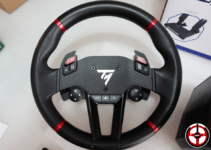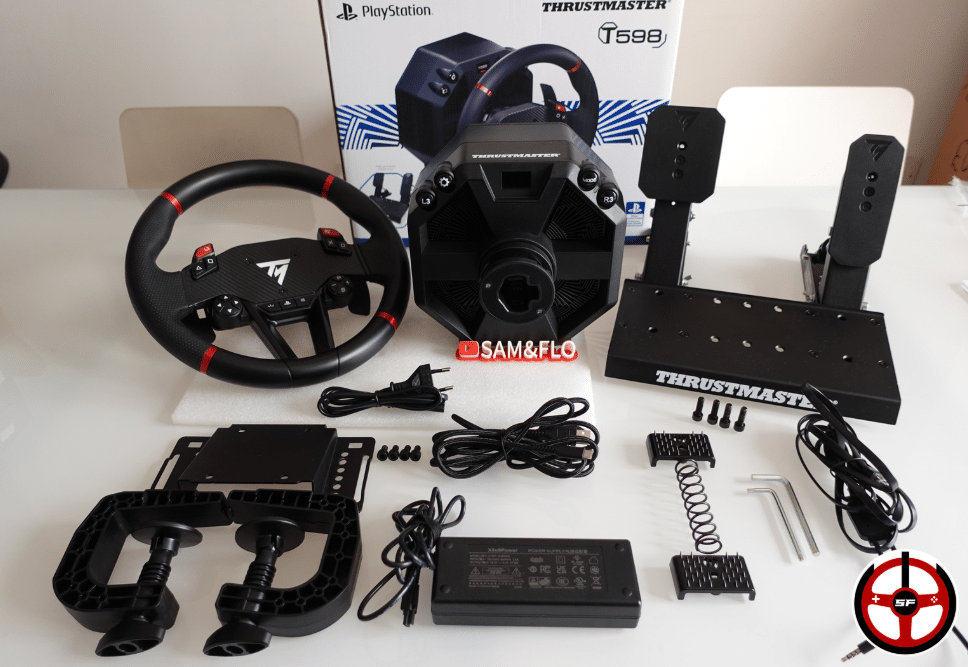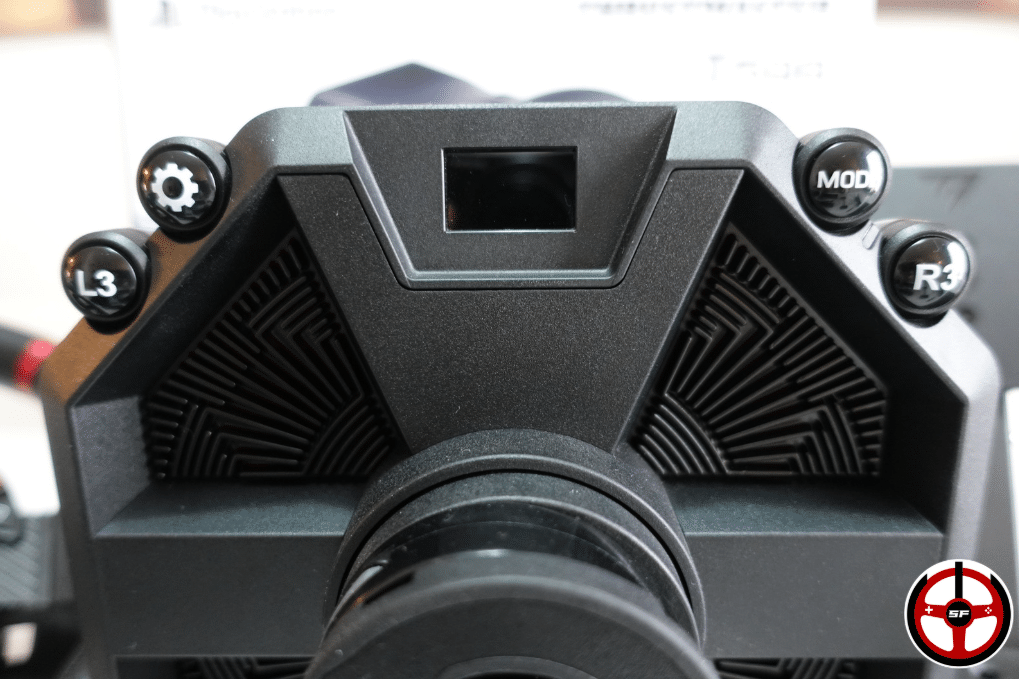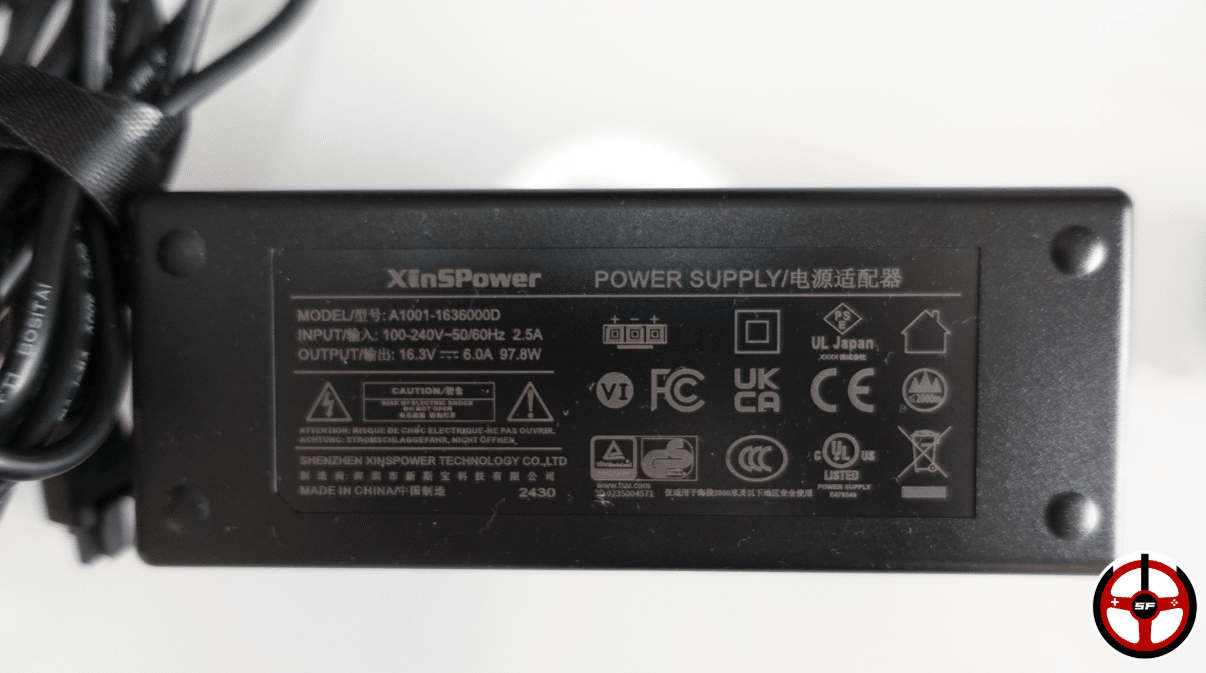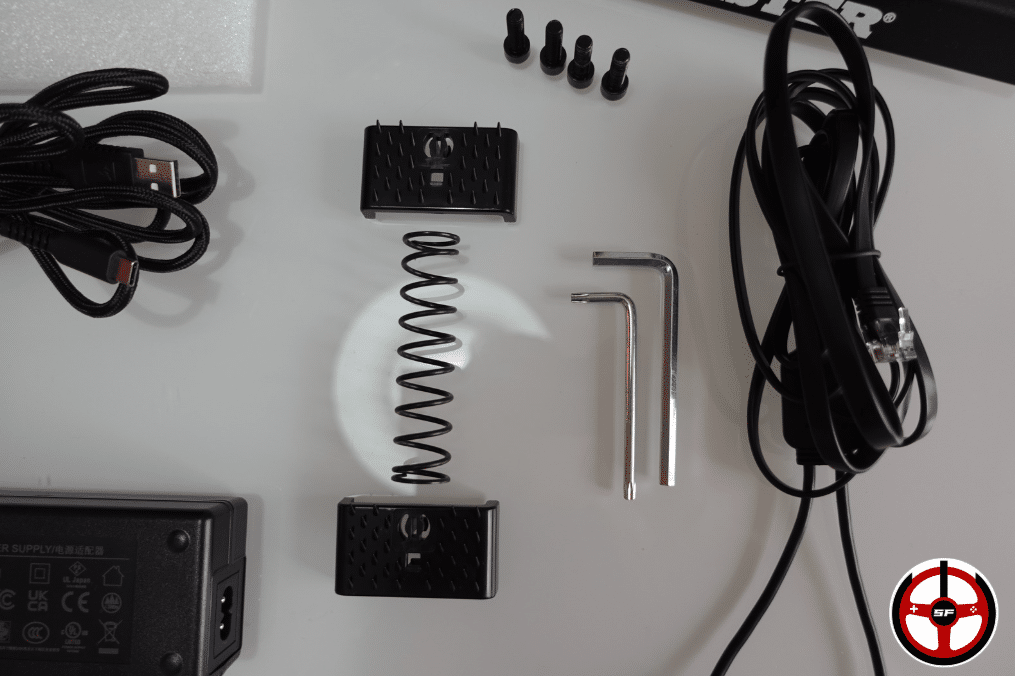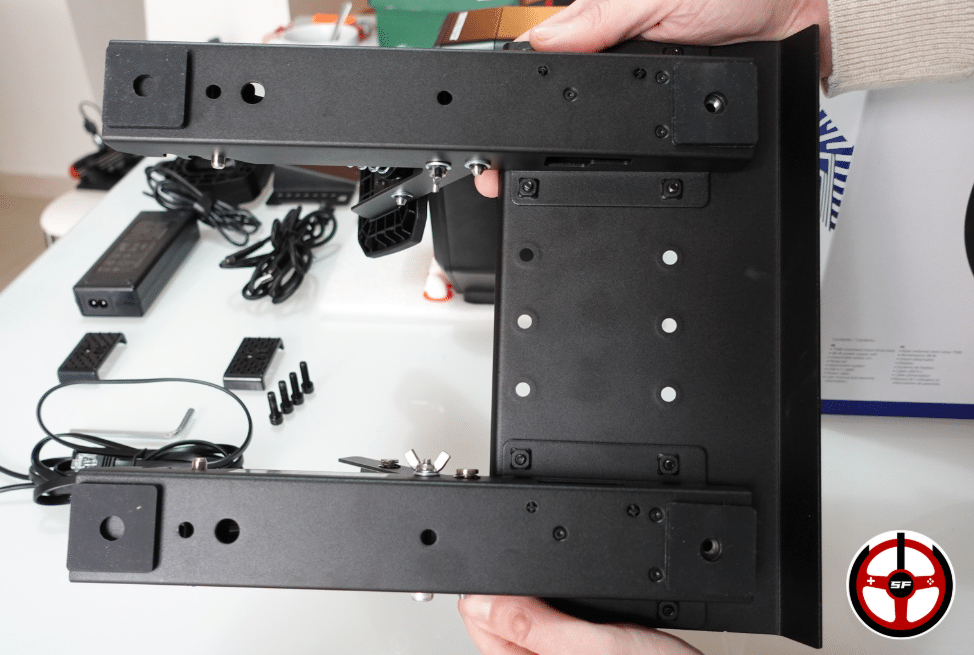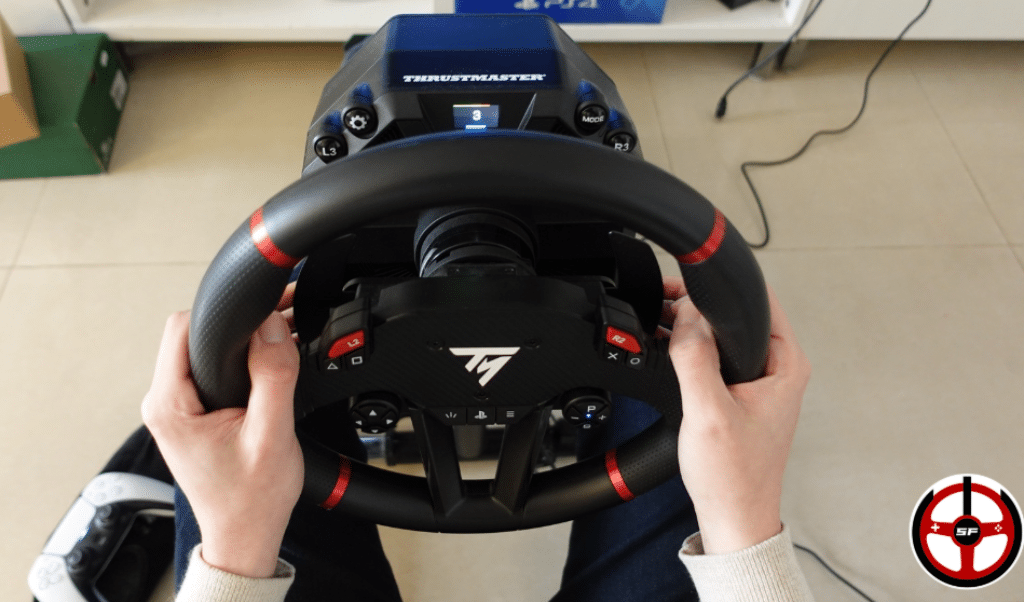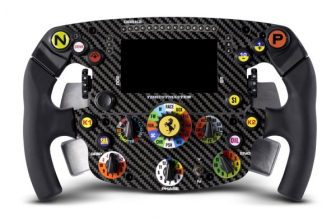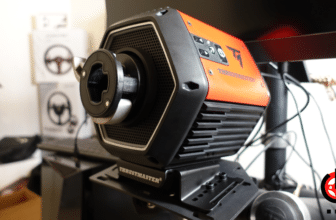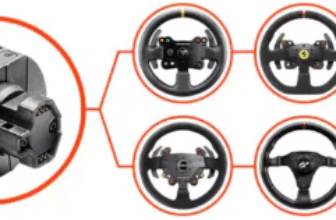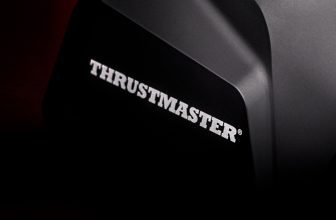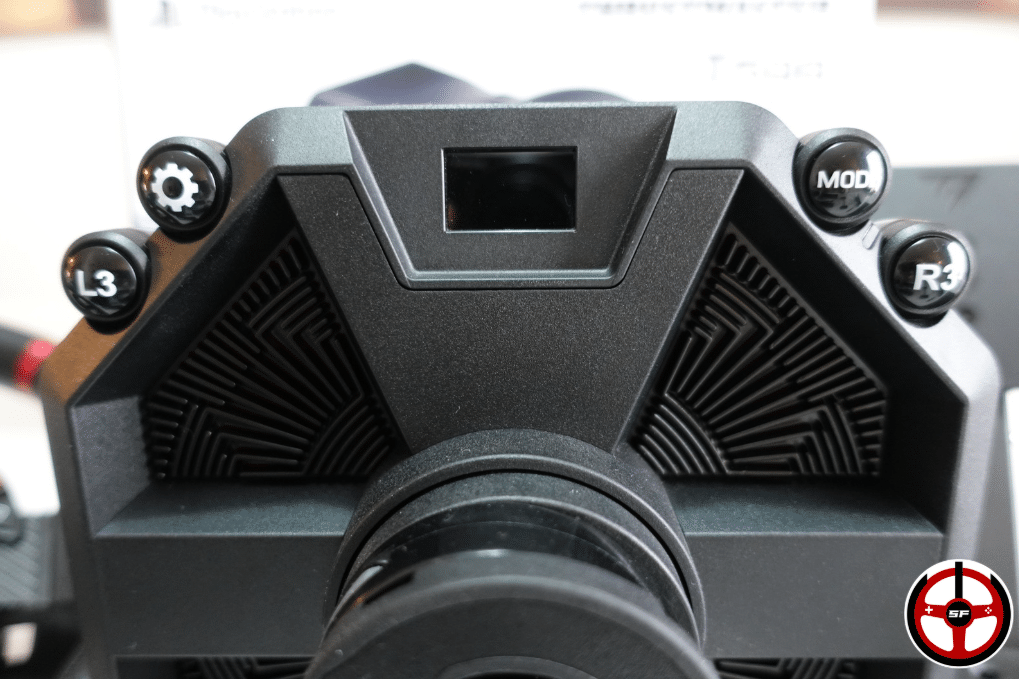
With the Thrusmtaster T598, the Franco-American brand has taken up a major challenge: reinventing the wheel. Or rather, the Direct Drive basics. Until now, everyone agreed that “conventional” Direct Drives equipped with servo motors derived from industrial motors were THE best solution for simracing. But Thrustmaster chose instead to analyze existing motors on the consumer market, to understand their advantages and shortcomings. Based on their findings, they decided to use another type of motor never before used in simracing: the Direct Axial Drive. Flo and I tested it alternately on Playstation 5 and PC for just over 3 months, and here are our conclusions!
Prices and deliveries
Technical specifications of the Thrustmaster T598 base unit

| Compatibility | PC, PS4, PS5. |
| Dimensions Weight | Depth excluding QR 11.8cm, Width 20.5cm, Height 21cm, 4,825Kg |
| Motor | Direct Axial Drive |
| Torque | Constant: 5Nm Overshoot capacity: 10Nm Slew Rate : Not communicated |
| Encoder | Not communicated |
| Turning range | 180° to 1080° Adjustable via software. |
| Connections | USB-C output to PC, Power supply socket, Shifer or handbrake connection, Pedalboard socket, 1 DIO connection, function as yet unknown. |
| Wheel mounting mode | Thrustmaster Quick Release |
Design and ergonomics
In the box:
- Base T598,
- Sportcar Wheel Add-on,
- Raceline LTE pedalset,
- 2 pedal grips for carpeting,
- Inclined stand for base and table clamps,
- 1 98W power supply and cord,
- 1 USB-C USB-A cable
- Jack/RJ12 cable for connecting pedalboard to base,
- Torx wrench for pedalboard adjustment,
- User manual.
When I first unpack, I discover the T598 base. Its metal casing with plastic front and rear cover plates is, admittedly, a distinctive design. But this design is no coincidence, as the struts (especially on the front) are a reminder of the PCB and its copper filaments, which are the real innovation of this model and its motor (I’ll come back to this in a moment).
Still on the front panel, I find 4 buttons (L3/R3/MODE/SETTINGS), a small 1.2″ display that will serve both to set the force feedback and to display telemetry information during the race. Then, of course, there’s the Thrustmaster Quick Release with its lever for attaching and quickly changing the steering wheel.
First observation: the base is bulky. Although it’s only 11.8cm deep (excluding QR), it’s wider and taller than its competitors, at 20.5cm wide and 21cm high. This height translates into a steering shaft whose center is positioned just over 10cm from the base. As we shall see, this is an important detail when it comes to installation.
What about the rear?

Well, on the rear panel, you’ll find the usual power socket to which you’ll connect the98W power supply, as well as sockets for shifters, pedals and USB-C to connect the base to your PC or PlayStation. But also a “DIO” port with an as yet unknown function, and the ON/OFF button. Something to do with Black Sabbath, perhaps?
An in-house motor that reinvents the wheel

I’ve shown you what’s on the outside of the base, now let’s take a look at what drives it: its motor! Because this is where Thrustmaster came up with a totally unexpected move. Rather than develop a conventional Direct Drive motor, the brand has opted for a Direct Axial Drive motor. And on paper, it’s a banger!
Because the Direct Axial Drive totally eliminates cogging (the notched effect in force feedback), with a perfectly fluid steering shaft that’s unrestrained in its movement. It also delivers unbeatable responsiveness compared with Direct Drive motors of equivalent torque, and drastically reduces production costs by doing away with copper coils… And finally, to ensure constant torque on which to add overshoot.
Oula Sam, you’re speaking Chinese! What’s Overshoot?
Hold on to your underpants! In a “normal” Direct Drive base, we talk about peak torque and constant torque. In the case of the T598, the base has a constant torque of 5Nm and will be able to hold this 5Nm throughout a race. But it doesn’t have a Peak. This is because the architecture of its Direct Axial Drive motor is not capable of creating a torque peak that lasts over time like conventional Direct Drives. For example, a Fanatec CSL DD has a peak torque of 8Nm, which it can deliver over several seconds/minutes, and a constant torque estimated by a wet finger at around 6 to 6.5Nm.
But that’s where it gets interesting. While the T598 can’t sustain a prolonged peak, it can double its force over a very short period. This is the famous Overshoot.
A concrete example? Imagine you’re on a long, fast, leaning bend. In this situation, the base is already sending you its 5Nm to give you the feeling of grip, tire load, suspension, etc. But where another 5Nm base would send you the feeling of grip, tire load, suspension, etc., the base is already sending you its 5Nm. But where another 5Nm base would be close to saturation and unable to send more force feedback details, the overshoot will enable the T598 to send very short FFB details up to 10Nm. As a result, this base is not only capable of holding very long sessions without loss of torque, butis also able to send more force on FFB details than its competitors at equal torque.
HARMONY technology
One of the technical advances brought by the T598 is the introduction of HARMONY technology. This produces high-frequency vibrations in the engine to create unprecedented effects. Of course, this isn’t the first time we’ve seen this kind of effect on Direct Drive bases. You’ll remember Logitech’s TrueForce or Fanatec’s FullForce on ClubSport DD and DD bases (although for the latter, Fullforce is not yet usable in game).
I’ll try to explain simply what it’s all about: all the bases on the market send force feedback into our hands, based on the physics of the game. We’ll find road effects, suspension effects, tire effects, glide effects, ABS effects in some cases, etc. etc. The signal sent by the game will be filtered to a greater or lesser extent depending on how the base firmware translates this signal into physical movements, and then by your personal force feedback settings. But to go even further, we can imagine adding other effects that overlay the force feedback to add even more immersion and a sense of connection with the car. This is where HARMONY technology comes in.
The Gear Jolt effect (shifting vibrations)
So, in the case of the T598, the first effect integrated thanks to HARMONY technology is Gear Jolt. A vibration effect each time the gearbox is shifted up or down. When you shift up or down a gear, the engine vibrates at high frequency for a short time, so you can feel the shift in your hands. What I found interesting was that, just like on the Logitech G Pro, if you install the base on a rigid chassis, these vibrations can even be transmitted into the chassis. In my case, I could feel these vibrations right down to the pedalboard.
On the other hand, this effect cannot be used on all games. For the time being, we’ll have to make do with the list of games on which Thrustmaster has been willing/able to integrate it.
Installing the T598 base
Before rolling, the base must be securely mounted on a support. There are three ways of doing this:
- Use the 4 M6 screw threads (6.3cm wide and 7.9cm deep).
- Use the inclined support supplied with the base, which screws into the underside of the motor (13.5cm wide and 7 holes with a maximum depth of 5.8cm).
- And if you’re on a desk or table, use the inclined support with the two plastic table clamps, also supplied in the box. These clamps are fitted with rubber pads for a firm grip on the table, and can be installed on tops up to 5cm thick (I’d recommend 4.5cm max for a good grip).
But as I said earlier, the base is high. And its steering shaft is 10cm from the base without even using the tilting support. Depending on the chassis or the height of the desk you’re going to install it on, this height can be a bit of a worry. In Flo’s case, it prevented her from seeing the entire PC screen, which was partly hidden by the base and steering wheel.
The simplest remedy for this is the good old cushion under the buttocks. Or the aluminum profile chassis for fine-tuning the height, but when you’re riding a T598 you rarely have a profile chassis.
PS/PC operating modes
Well, great news, just after the release of our review: Gran Turismo has finally received an update that natively supports the T598.
So Flo and I are reinstalling the base station in our living room to test the new force feedback features it brings. As soon as we’ve finished the new tests, we’ll share our findings with you 🙂

I’ve installed the base, everything’s plugged in and up to date (updates are made via the software I’ll talk about below). All that’s left is to start it up by pressing the power button on the back right of the case. Once that’s done, I check that the base is in the right operating mode. I press the MODE button directly on the base, then select the right mode using the “up-down” buttons on the steering wheel. Once the correct mode has been activated, I press the mode button again to exit the menu and move on to the next step.
| PlayStation Mode 1 (Blue) | This is a “compatibility” mode that makes the base look like a Thrustmaster T-GT 2 (belt base). This mode works with all games, but the force feedback received is adapted to a belt-driven wheel and not optimized for a Direct Drive. |
| PlayStation Mode 2 (Red) | With this second mode, the base is correctly recognized as a T598 and will receive Direct Drive-optimized force feedback. However, to date, no games are compatible. |
| PC mode (Green) | If you’re a PC user, this is the only mode to use. Integrations and the signal received are to be seen on a case-by-case basis, depending on the games you’re playing. These integrations have a direct impact on the gaming experience, because without them, you’ll have no Inertia settings, no on-screen display and no Gear Jolt. I’ve listed the games and their compatibilities here. |
Force feedback settings on PlayStation and PC
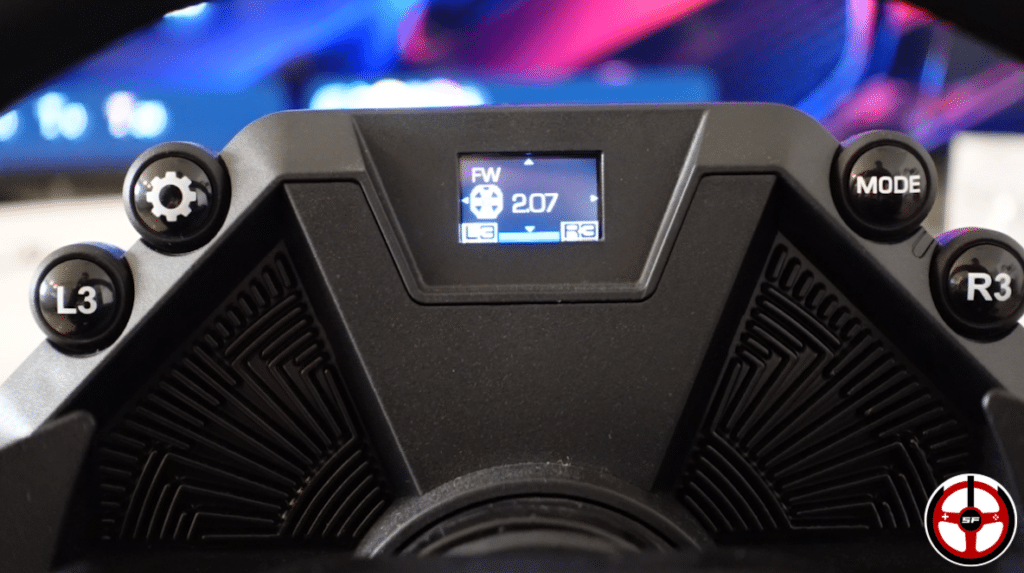
One of Fanatec’s major advantages is the screens on their bases and/or steering wheels, which allow you to adjust force feedback directly on the track, without having to go through the software. Well, Thrustmaster has decided to do the same, and so much the better! By pressing the “settings” button on the base, then navigating with the steering wheel’s directional buttons, you’ll access the FFB settings, as well as the steering wheel rotation settings, which I’ll explain below!
MASTER (Maximum torque deployed by the base)
MODE
Inertia
Friction
Boost Low et Boost High
Speed
Damper
Spring
Gear Jolt
End Stop
Angle
Dual Clutch
The Thrustmaster FFB settings software
Well, between you and me, I think we can be frank. When it comes to software, Thrustmaster has been regarded as a dinosaur for several years now. When the T818 was released, many voices (including mine) were raised in protest at the ridiculously limited options offered to players on force feedback settings. Where ALL competitors offer coherent, complete software with “up-to-date” graphical interfaces, Thrustmaster offered us a configuration page worthy of Windows XP, with very incomplete options.
Their teams understood the problem and (finally) got down to work. I was therefore delighted to download the dedicated software to make my settings on a PC. But then, SURPRISE ! The force feedback settings page is simply not accessible because it’s not finished. For the moment, it’s only used to update your hardware’s firmware.
The Thrustmaster Sportcar steering wheel

| Diameter | 30cm. |
| Materials | Plastic, metal. |
| Grips | Stitched rubber. |
| Vibrations | No |
| Paddles | 2 magnetic metal pallets. |
| Pallet operating noise | 69dB. |
| Customizable buttons (functions counted for PC use) | 17 configurable buttons including 1 4-mode selector button and 3 associated buttons. Total configurable functions: 26, including paddles. |
| LED display | LED mode display for “multi-select” buttons. |
| Screen | No. |
| Quick Release | Non-detachable Thrustmaster QR. |
| Base compatibility | Thrustmaster T598 and T818. |
Cheap bundles mean entry-level wheels. And the Thrustmmaster Sportcar is no exception. It’s a 30cm-diameter, 814-gram round plastic model with perforated rubber grips on both sides, equipped with the new-generation QR. The design features 4 small red aluminum rings. It’s neatly done, but it’s clear that this is a low-cost model. The good news is that, despite the materials used, it doesn’t bend too much under stress and doesn’t crack at every turn. It’s basic, but it does the job.
The 17 buttons have a very “console controller” click, with a pressure of 250 grams on activation. I liked the fact that the bottom right of the steering wheel has 3 buttons that change function by clicking on the S button(selector). As a result, there are 4 modes of use for the -, and P buttons. And to indicate which mode is active, a small LED changes color between the buttons.

This brings us to a total of 24 functions that can be configured on the PC (on the PlayStation, of course, you won’t be able to reconfigure the PS/option towers, etc.). Not to mention the two magnetic metal paddles, which require 1Kg to activate and are very quiet, with a maximum reading of 69dB.
Raceline Pedals LTE (Long Term Evolution) pedalset
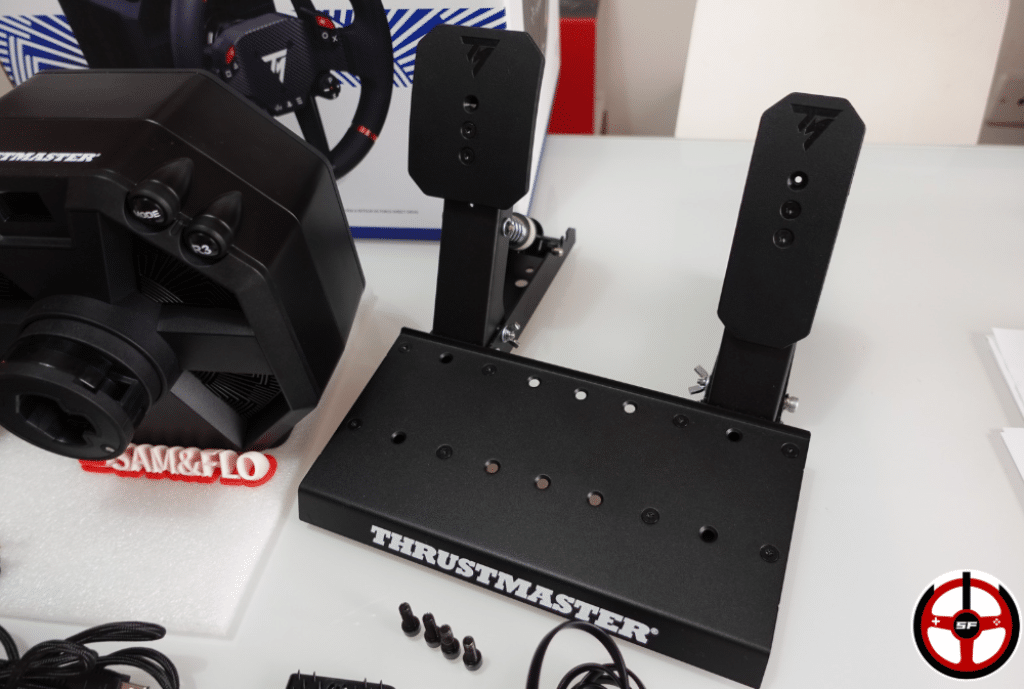
| Materials | Steel, plastic. |
| Pedals | 2 pedals (clutch option coming soon). |
| Gas pedal | Spring-loaded (2 springs supplied), Magnetic H.E.A.R.T. sensor, NC resolution. |
| Brake | Spring-applied, Magnetic H.E.A.R.T. sensor, NC resolution. |
| Vibrations | No |
| Connections | A 3.5mm jack on each pedal connects them to a cord for plugging into the base. |
As for the pedalboard, you’ll soon realize that it’s just like the steering wheel: very simple and inexpensive. The construction is directly inspired by the Fanatec CSL Pedals, using the same materials (metal and plastic). This Raceline LTE consists of a gas pedal and a brake, both with spring-loaded movements and equipped with magnetic sensors. So it’s the movement of the pedal that determines braking power, not the weight applied. This will do the job for a beginner, but a rider in search of performance and realism will have to wait until Thrusmtaster finally releases the Load Cell kit, which will complete the pedalset in a few months’ time.
It can be placed on the floor thanks to its rubber pads, on carpet with its non-slip grips, or on a rigid chassis by screwing it directly to your support plate.
Adjustment options are similarly limited. You can raise or lower the pedal pads via holes spaced 1.5cm apart. Change the hardness of the pedal movement without tools via 3 notches (no tools required) and change the gas pedal spring for a harder model. Finally, move the pedals from left to right using the holes in the heel bracket.
There’s no angle or stop adjustment, and the feel is linear. In short, it’s entry-level stuff that’ll do the job for beginners, but which you’ll need to upgrade quickly if you want to get the hang of it.
On-track testing on PlayStation and PC
Flo and I decided to start by testing the PlayStation 5 with the games Gran Turismo 7, Assetto Corsa Competizione and F1. The settings provided by the brand were “ok” without really revealing the full potential of the engine. So I made my own little adjustments and it was immediately more to my liking. Never underestimate the tuning stage!

The first thing that struck me was the base’s responsiveness, which was very, very good. In this respect, it outperforms its competitors in the 5Nm range. Then there’s the overall driving pleasure. The Gear Jolt effect, which sends out vibrations when shifting gears, is a very cool addition to add immersion, and I can’t wait to see what the FFB will deliver once the integrations are done, as it’s very very likely that the T598 will in future be able to provide more track detail than a CSL DD or Moza R5, for example.
After a few weeks of discovery on the PS5, we set up the base on a fixed chassis for PC use. And then, several things happened:
Firstly, not having FFB, Gear Jolt and screen integrations on many games is frustrating. Especially as the base is capable of some very fine things! When you go for a spin on sims like Race Room or RFactor 2, you’re sometimes treated to moments of real fun on the track. Plenty of detail thanks to overshoot, zero cogging, no drop in torque even over long sessions, a steering wheel that despite its very entry-level materials is pleasant on the track… In short, there are plenty of good things to say.
A word about the pedalset?
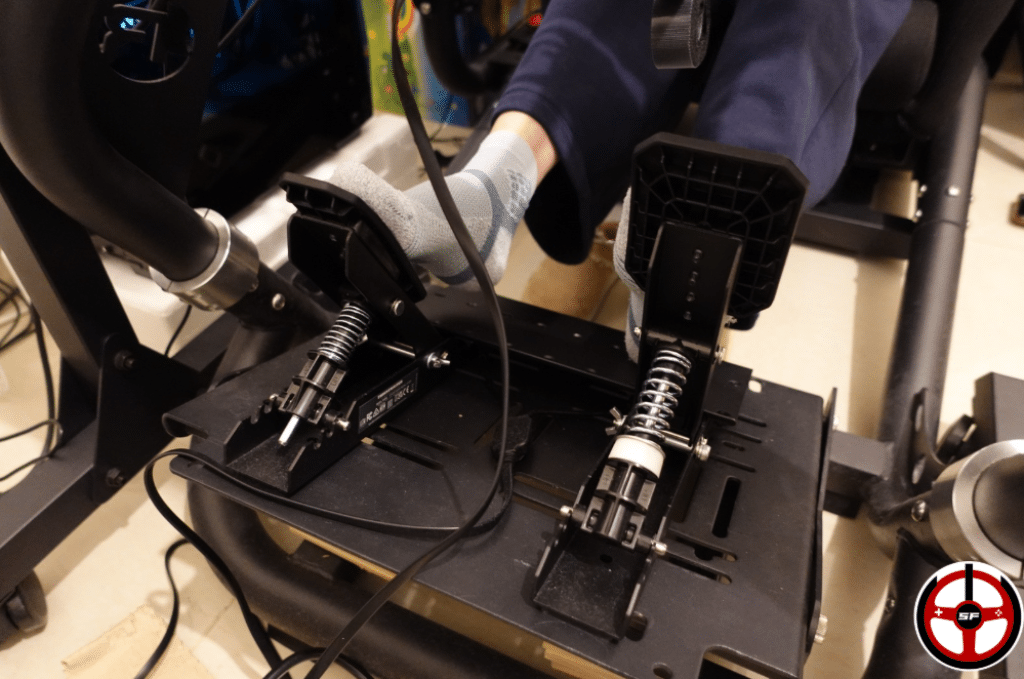
Well, I’m not going to give you the umpteenth lecture on why Load Cells are 1,000 times better than magnetic brake sensors… The fact is, the pedalset does its job, no more and no less, for a mass-market entry-level model.
The hardness settings will enable new players to quickly find an acceptable feel. Until we move on to a real simracing pedalboard and finally get some time on the clock!
Gearboxes on PC: Bin… ET ME**E!
On the console, I was able to connect my TH8S gearbox (which I’d bought separately almost a year ago) directly to the T598 base. Everything worked fine and I was happy. Then I wanted to do the same on a PC, and what a surprise! On a PC, the gearbox isn’t recognized if you plug it into the base unit. You have to connect it to the PC via USB. But really, we asked Thrustmaster for validation and it’s validated.
Let me repeat that slowly: on a PC, you can’t plug the Thrustmaster gearbox into the special Shifters socket on the Thrustmaster base, it won’t work. You have to connect the gearbox to your PC via a USB port.
No comment.
Why does it itch when I’m not playing?
Ah, I’ve been thinking about it, and you’ll certainly notice if you’ve got a T598 in your hands: when you’re not “playing”, the steering wheel sends out little vibrations with a high-pitched sound. It’s very slight, but it caught our attention. So we put the question to Thrustmaster, who replied as follows:
Concerning your question about off-game vibrations, as the movement is totally “disconnected” from FFB information and has no cogging (so no friction), it is totally free to move and therefore more sensitive to micro tremors. In play, it’s the game that takes control of the T598, which stabilizes the steering wheel. So there’s no impact on the gaming experience, but it’s true that it can be a little confusing off-game at first.
Xavier Pieuchot of Thrustmaster
Now you know where it comes from. But don’t worry, as Xavier says, as soon as you start a game, it goes away completely 😉
5Nm only?
Generally speaking, I don’t recommend buying a Direct Drive with less than 8Nm. Because the whole point of DDs, apart from the fluidity of movement, is their ability to bring out fine details and their great responsiveness, which means you’re much more connected to the vehicle. On these two points, the small motors are not up to the task.

But there are two things to bear in mind about the T598. Firstly, it’s capable of really holding its constant 5Nm over the long term, and its responsiveness is far superior to some 8 or even 10Nm models. And above all, it’s capable of doubling this torque in short bursts thanks to the Overshoot. That changes everything!
In the end, we really didn’t feel like we had a 5Nm between our fingers. So let’s not exaggerate. Performance won’t be the same as with a normal 10Nm Direct Drive, as maximum cornering force is limited to 5Nm on the T598, but overall, the base unit manages to play hardball and fool its audience.
Engine warm-up management: Oh yes!
As always, our tests include a warm-up test that always follows the same protocol to determine whether a base will be able to hold up over long sessions. We’re sure that not many T598 gamers will be doing 24-hour endurance tests, but at least you’ll have the information!
Closed, unventilated room.
Ambient temperature: 21°C.
FFB at maximum on the base and FFB in play at the saturation limit.
Standard test: minimum 100 laps in an Indycar on an oval until overheating or temperature stabilization.
So, in concrete terms, I took a beating. After about 30 minutes, I’d reached a case temperature of 50°, which in the very difficult conditions in which I’d put the base is a very good result. More importantly, the next 30 minutes only saw the temperature rise by a further 2.5°.
So, we can say that the heating management was well managed BUT, as I always like to push my tests a little further, I decided to force overheating to see at what temperature the base would start to take me out of torque.
And… I pushed, pushed, pushed… Minutes multiplied, then became half-hours… And I lost. The base beat me. I mean really beat me, physically! Not only did I never manage to get it up to more than 57.4°, even if I forced it like a pig, but I also jammed my neck and shoulders in the process, which meant 2 very unpleasant days behind the wheel.
Bravo Thrustmaster, you got me. But I’ll have my revenge!
Who would I recommend the Direct Drive Thrustmaster T598 to?
If you’re a PlayStation gamer looking for a simple, effective bundle that delivers good performance at a contained price, then yes, the T598 is an interesting choice. It’s packed with technology that’s only waiting to be developed to enhance on-track enjoyment in the months to come, and we’re keeping our fingers crossed that FFB integrations will follow suit just as quickly.
On the other hand, if you’re a PC-only rider, this isn’t the most advanced/upgradeable model you’ll find at this price.

